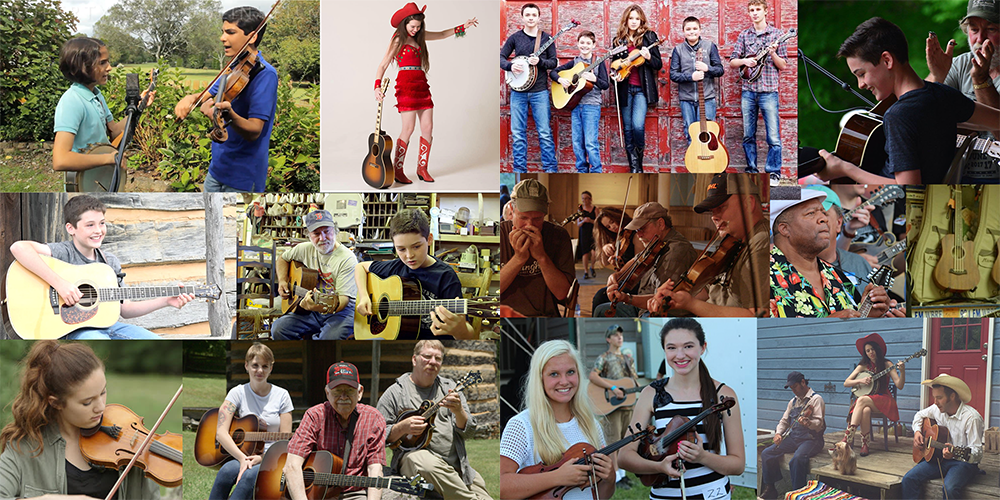EASY ED’S BROADSIDE: They’re Fiddlin’ Down in Galax

Featured musicians in the film 'Fiddlin''
Back in 1965, I was a 13-year-old kid growing up in the suburbs of Philadelphia who loved country music. We had our own local station all the way down on the right side of the AM dial, and on Saturday nights I was able to tune my radio into the WWVA Jamboree from Wheeling, West Virginia. I remember listening to Cousin Wilbur Wesbrooks, Esco Hankins, David Houston, Jim Greer’s Mac-O-Chee Valley Folks, Red Smiley and His Bluegrass Cut-Ups, The Stanley Brothers, Mary Lou Turner, and a few others whose names I can no longer recall. And in a complete clash of pre-internet culture, I was also watching American Bandstand every afternoon, following The Beatles along with all the other British Invasion bands, as well as doo-wop, rockabilly, Elvis, Joan Baez, and Bob Dylan. I was sipping a musical cocktail for sure.
As a music collector and armchair archivist, I’m more than a bit embarrassed to admit that it took me about 30 years until I began to understand the origins and influences of country music, and specifically the development and differences between bluegrass and old-time. If the latter is a genre that holds any interest for you, or if you simply loved Ken Burns’ Country Music and yearn for more, there’s a film by the name of Fiddlin’ that has made the rounds at film festivals, had a very limited theater run, and is now available for sale and viewing on several streaming sites including Kanopy, Apple TV, and Amazon Prime.
Back in 2016, Vicki Vlasic and Julie Simone — Blue Ridge mountain natives, filmmakers, and sisters — began a Kickstarter campaign for post-production work for a project sharing the roots and culture of old-time mountain music and bluegrass. Centered around the Old Fiddlers Convention in Galax, Virginia, which will celebrate its 85th anniversary this year, Fiddlin’ brings cameras along for interviews with a number of musicians who travel from all over the world and let us in as they socialize, sing, dance, play, and compete.
Simone and Vlasic’s daughters, sons, nieces and nephews, sisters, and friends pitched in to help with the film. Their mom cooked for everyone while their dad provided his RV for the crew. In addition to getting help from the family, they specifically sought out and recruited other women to join the team, accounting for nine out of the 13 producers. Primarily self-funded, along with the money raised from Kickstarter they also received a grant from the Rogovy Foundation. You probably can tell that this independent grassroots effort was one of dedication, hard work, and a passion for the music, history, culture, and people of this Appalachian region.
While music takes center stage throughout the film — with interviews and performances from Wayne Henderson, Presley Barker, Dori Freeman, Kitty Amaral, Eddie Bond, Karen Carr, Martha Spencer, Annabelle Watts, Ivy Phillips, Uma Peters, Giri Peters, and Virginia’s state folklorist, Jon Lohman — there are also conversations and stories about growing up in the area around Galax and how it’s changed.
Once an industrial town, in the 1960s it was home to six furniture factories, four textile companies, a lumber mill, two department stores, a bottling company, and two creameries. Over the decades, as the economy went global, thousands of jobs were lost in a town that has a population of 6,500 people. Fortunately, Galax revitalized its downtown area and took advantage of a tourism boom that drew people to the area for its thriving traditional music and arts scene. In addition to the Old Fiddlers Convention, there is a number of custom musical instrument makers and it is home to the Chestnut School of the Arts.
What I found the most interesting about Fiddlin’ is the emphasis on the kids who are keeping this music alive. JAM, which stands for Junior Appalachian Musicians, is a program whose mission is to “provide communities with the tools and support they need to teach children to play and dance to traditional old time and bluegrass music.” An after-school program beginning in fourth grade and offered in 30 communities throughout several states, it gives small group instruction on instruments common to the Appalachian region, such as fiddle, banjo, and guitar.
Programs like JAM are nonprofit and rely on volunteers, donations, and grants to continue to provide services to the community, which is especially important as federal funding for arts programs seems more and more in doubt. For the past two years, the Trump administration has attempted to defund the National Endowment for the Arts (NEA), arguing that it’s not considered a core federal responsibility, but Democrats in the House and Senate have been fighting to keep funding in place.
Fiddlin’ succeeds in not only making the case for how music connects communities and generations, but also in helping to demystify the stereotypes city dwellers have about country folk. Yes, they speak with a twang and might dress differently than us, but there is a commonality for the love of family, country, our heritage and traditions, and the joy that this music brings to many. Track this film down, clear out the furniture, roll up the carpet, and dance. It’s good for your soul.
Many of my past columns, articles, and essays can be accessed here and at my own site, therealeasyed.com. I also aggregate news and videos on both Flipboard and Facebook as The Real Easy Ed: Americana and Roots Music Daily. My Twitter handle is @therealeasyed and my email address is easyed@therealeasyed.com.




